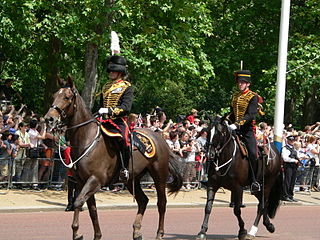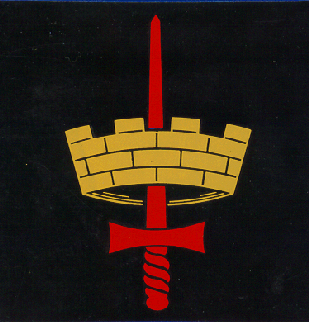
The Royal Regiment of Artillery, commonly referred to as the Royal Artillery (RA) and colloquially known as "The Gunners", is one of two regiments that make up the artillery arm of the British Army. The Royal Regiment of Artillery comprises thirteen Regular Army regiments, the King's Troop Royal Horse Artillery and five Army Reserve regiments.

St John's Wood is a district in the City of Westminster, London, England, about 2.5 miles (4 km) northwest of Charing Cross. Historically the northern part of the ancient parish and Metropolitan Borough of Marylebone, it extends from Regent's Park and Primrose Hill in the east to Edgware Road in the west, with the Swiss Cottage area of Hampstead to the north and Lisson Grove to the south.

Woolwich is a town in southeast London, England, within the Royal Borough of Greenwich.

The King's Troop, Royal Horse Artillery, is a ceremonial unit of the British Army, quartered at Woolwich. It is a mounted unit and all of its soldiers are trained to care for and drive teams of six horses, each team pulling a First World War-era QF 13-pounder gun; six teams are used in the unit's Musical Drive. The Troop's duties include firing salutes on royal and state occasions, participation in parades, and the duties of the King's Life Guard at Horse Guards for one month each year. The unit provides the gun carriage and team of black horses for state funerals. The unit is most often seen providing gun salutes on state occasions in Hyde Park, and Green Park.

Woolwich Common is a common in Woolwich in southeast London, England. It is partly used as military land and partly as an urban park. Woolwich Common is a conservation area. It is part of the South East London Green Chain. It is also the name of a street on the east side of the common, as well as an electoral ward of the Royal Borough of Greenwich. The population of the ward at the 2011 Census was 17,499.

The Royal Horse Artillery (RHA) was formed in 1793 as a distinct arm of the Royal Regiment of Artillery to provide horse artillery support to the cavalry units of the British Army. Although the cavalry link remained part of its defining character, as early as the Battle of Waterloo the RHA was sometimes deployed more along the lines of conventional field artillery, fighting from comparatively fixed positions.

Woolwich Garrison is a garrison or station of the British Army. Geographically it is in Woolwich, in the London Borough of Greenwich. In terms of command, it is within the Army's London District.

London District (LONDIST) is the name given by the British Army to the area of operations encompassing the Greater London area. It was established in 1870 as Home District.

5th Regiment Royal Artillery is a regiment of the Royal Artillery in the British Army. It was formed in 1939 as 5th Regiment Royal Horse Artillery before being redesignated in 1958. It currently serves in the Surveillance and Target Acquisition role and is equipped with radars and acoustic sound ranging equipment; it also provides Special Observation Post teams.
E Battery Royal Horse Artillery is a Close Support Battery of 1st Regiment Royal Horse Artillery. It is currently based in Purvis Lines in Larkhill Camp.

D Battery Royal Horse Artillery are a Close Support Battery of 3rd Regiment Royal Horse Artillery They are currently based in Albemarle Barracks in Newcastle Upon Tyne.
J Battery Royal Horse Artillery are a Close Support Battery of 3rd Regiment Royal Horse Artillery. They were currently based in Caen Barracks in Hohne, Germany.
M (Headquarters) Battery Royal Horse Artillery is the Headquarters Battery of 3rd Regiment Royal Horse Artillery, part of the Royal Horse Artillery of the British Army. As of 2015, it is based at Albemarle Barracks, Northumberland, England. The Battery Commander is Maj B Johnston RHA.
N Parachute Battery Royal Horse Artillery is a Tactical Group Battery of 7th Parachute Regiment Royal Horse Artillery. They are currently based in Albemarle Barracks in Northumberland.
In September 1939, the British Army was in process of expanding their anti-aircraft and mobile assets. Among these new changes was the formation of Anti-Aircraft Command which was formed on 1 April 1939, and the 1st Armoured Division formed in 1937. The list below will include the British Army units, colonial units, and those units which were in the process of formation.
IV Brigade, Royal Horse Artillery was a brigade of the Royal Horse Artillery which existed in the early part of the 20th century. It served with 3rd Cavalry Division throughout World War I but was dissolved shortly thereafter.
III Brigade, Royal Horse Artillery was a brigade of the Royal Horse Artillery which existed in the early part of the 20th century. It served with the 1st and 2nd Cavalry Divisions on the Western Front throughout World War I.
I Parachute Battery Royal Horse Artillery is the Headquarters battery of 7th Parachute Regiment Royal Horse Artillery, part of the Royal Horse Artillery of the British Army, currently based in Albemarle Barracks in Newcastle Upon Tyne.
H Battery Royal Horse Artillery is a battery of 1st Regiment Royal Horse Artillery, part of the Royal Horse Artillery of the British Army. As of 2015, it is based at Albemarle Barracks, Northumberland, England and is equipped with GMLRS.

Royal Artillery Barracks, Woolwich, is a barracks of the British Army which forms part of Woolwich Garrison. The Royal Regiment of Artillery had its headquarters here from 1776 until 2007, when it was moved to Larkhill Garrison.












